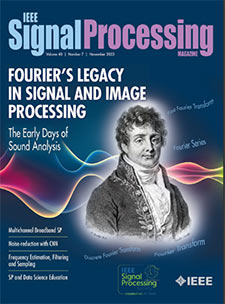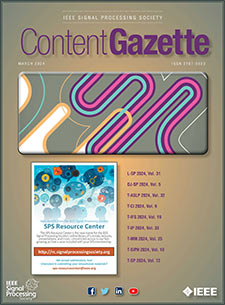- Our Story
- Publications & Resources
- Publications & Resources
- Publications
- IEEE Signal Processing Magazine
- IEEE Journal of Selected Topics in Signal Processing
- IEEE Signal Processing Letters
- IEEE/ACM Transactions on Audio Speech and Language Processing
- IEEE Transactions on Computational Imaging
- IEEE Transactions on Image Processing
- IEEE Transactions on Information Forensics and Security
- IEEE Transactions on Multimedia
- IEEE Transactions on Signal and Information Processing over Networks
- IEEE Transactions on Signal Processing
- IEEE TCI
- IEEE TSIPN
- Data & Challenges
- Submit Manuscript
- Guidelines
- Information for Authors
- Special Issue Deadlines
- Overview Articles
- Top Accessed Articles
- SPS Newsletter
- SigPort
- SPS Resource Center
- Publications Feedback
- Publications FAQ
- Blog
- News
- Dataset Papers
- Conferences & Events
- Community & Involvement
- Professional Development
- For Volunteers
- Information for Authors-OJSP
-
Home
Conferences14 April 2025 to 17 April 2025Conferences Events IEEE JSTSP Article IEEE Signal Processing Magazine IEEE TIFS Article IEEE TMM Article IEEE TSP Article Jobs in Signal Processing Lectures Machine Learning Seasonal Schools Signal Processing News SPM Article SPS Distinguished Lectures SPS Newsletter Article SPS Webinar SPS Webinars SPS Webinar Series Webinar webinars
-
Our Story
What is Signal Processing?

The technology we use, and even rely on, in our everyday lives –computers, radios, video, cell phones – is enabled by signal processing. Learn More » -
Publications & Resources
-
SPS Resources
- Signal Processing Magazine The premier publication of the society.
- SPS Newsletter Monthly updates in Signal Processing
- SPS Resource Center Online library of tutorials, lectures, and presentations.
- SigPort Online repository for reports, papers, and more.
- SPS Feed The latest news, events, and more from the world of Signal Processing.
-
SPS Resources
-
Conferences & Events
-
Community & Involvement
-
Membership
- Join SPS The IEEE Signal Processing Magazine, Conference, Discounts, Awards, Collaborations, and more!
- Chapter Locator Find your local chapter and connect with fellow industry professionals, academics and students
- Women in Signal Processing Networking and engagement opportunities for women across signal processing disciplines
- Students Scholarships, conference discounts, travel grants, SP Cup, VIP Cup, 5-MICC
- Young Professionals Career development opportunities, networking
- Get Involved
-
Technical Committees
- Applied Signal Processing Systems
- Audio and Acoustic Signal Processing
- Bio Imaging and Signal Processing
- Computational Imaging
- Image Video and Multidimensional Signal Processing
- Information Forensics and Security
- Machine Learning for Signal Processing
- Multimedia Signal Processing
- Sensor Array and Multichannel
- Signal Processing for Communication and Networking
- Signal Processing Theory and Methods
- Speech and Language Processing
- Technical Working Groups
- More TC Resources
-
Membership
-
Professional Development
-
Professional Development
- Mentoring Experiences for Underrepresented Young Researchers (ME-UYR)
- Micro Mentoring Experience Program (MiME)
- Distinguished Lecturer Program
- Distinguished Lecturers
- Distinguished Lecturer Nominations
- Past Lecturers
- Distinguished Industry Speaker Program
- Distinguished Industry Speakers
- Distinguished Industry Speaker Nominations
- Industry Resources
- IEEE Training Materials
- Jobs in Signal Processing: IEEE Job Site
-
Career Resources
- SPS Education Program Educational content in signal processing and related fields.
- Distinguished Lecturer Program Chapters have access to educators and authors in the fields of Signal Processing
- PROGRESS Initiative Promoting diversity in the field of signal processing.
- Job Opportunities Signal Processing and Technical Committee specific job opportunities
- Job Submission Form Employers may submit opportunities in the area of Signal Processing.
-
Professional Development
-
For Volunteers
-
For Board & Committee Members
- Board Agenda/Minutes* Agendas, minutes and supporting documentation for Board and Committee Members
- SPS Directory* Directory of volunteers, society and division directory for Board and Committee Members.
- Membership Development Reports* Insight into the Society’s month-over-month and year-over-year growths and declines for Board and Committee Members
-
For Board & Committee Members
Popular Pages
Today's:
- Submit a Manuscript
- Information for Authors
- IEEE Transactions on Multimedia
- IEEE/ACM Transactions on Audio Speech and Language Processing
- IEEE Transactions on Information Forensics and Security
- (MLSP 2024) 2024 IEEE International Workshop on Machine Learning for Signal Processing
- (ACSSC 2024) 2024 Asilomar Conference on Signals, Systems, and Computers
- IEEE Transactions on Signal Processing
- Information for Authors-SPL
- IEEE Transactions on Image Processing
- Conferences & Events
- Guidelines
- IEEE Signal Processing Magazine
- IEEE Signal Processing Letters
- Conference Call for Papers
All time:
- Information for Authors
- Submit a Manuscript
- IEEE Transactions on Image Processing
- 404 Page
- IEEE/ACM Transactions on Audio Speech and Language Processing
- IEEE Transactions on Information Forensics and Security
- IEEE Transactions on Multimedia
- IEEE Signal Processing Letters
- IEEE Transactions on Signal Processing
- Conferences & Events
- IEEE Journal of Selected Topics in Signal Processing
- Information for Authors-SPL
- Conference Call for Papers
- Signal Processing 101
- IEEE Signal Processing Magazine
Last viewed:
- Information for Authors-SPM
- Information for Authors-SPL
- (RadarConf 2020) 2020 IEEE Radar Conference
- SPS Scholarship Program
- Conferences
- Conference Call for Papers
- (MLSP 2024) 2024 IEEE International Workshop on Machine Learning for Signal Processing
- 404 Page
- Conferences & Events
- Submit a Manuscript
- Publications & Resources
- Past DIS Speakers
- Distinguished Lecture: Prof. Kush Varshney (IBM Research)
- Information for Authors
- IEEE Transactions on Multimedia
Recent Patents in Signal Processing (October 2015) – Iris recognition
You are here
Newsletter Menu
Newsletter Categories
Top Reasons to Join SPS Today!
1. IEEE Signal Processing Magazine
2. Signal Processing Digital Library*
3. Inside Signal Processing Newsletter
4. SPS Resource Center
5. Career advancement & recognition
6. Discounts on conferences and publications
7. Professional networking
8. Communities for students, young professionals, and women
9. Volunteer opportunities
10. Coming soon! PDH/CEU credits
Click here to learn more.
News and Resources for Members of the IEEE Signal Processing Society
Recent Patents in Signal Processing (October 2015) – Iris recognition
For our October 2015 issue, we cover recent patents granted in the area of iris recognition. The section below covers patents granted recently for various iris recognition algorithms, iris image quality improvement, off-angle gaze correction, security improvements for iris recognition systems, designing a short distance iris camera, and combined face and iris recognition.
A system introduced in patent no. 9,122,926 receives an iris image and segments the iris region. The segmented iris region is mapped to a unit disk and partitioned into local iris regions (or sectors) as a function of the radius and angle The system calculates localized Zernike moments for a plurality of regions of the unit disk. The localized Zernike moment includes a projection of the local iris region into a space of Zernike polynomial orthogonal basis functions. The system generates an iris feature set from the localized Zernike moments for each partitioned region, excluding the regions which are comprised by occlusion. The iris features are weighted based on the conditions of blur, gaze and occlusion of the iris region. A probe iris image is then matched to a plurality of iris images in a database based on the distance of its feature set to the corresponding plurality of iris feature sets.
The invention no 9,087,238 relates to an iris recognition device and method capable of improving iris recognition accuracy. To enhance iris recognition accuracy in consideration of variation in pupil size and iris region due to changes in intensity of lighting, the iris recognition device and method are configured to obtain multiple iris images having different iris sizes by capturing iris images of a person to be enrolled with a camera while adjusting brightness of lighting so that the iris size of the person to be enrolled varies from a maximum size to a minimum size, store the obtained iris images and associated iris size information for enrollment in a database interworking with the iris recognition device, and select enrolled iris images having an iris size most similar to that of an iris image captured by the camera for identification among many enrolled iris images for similarity measurement.
A method of verifying the authenticity of an eye provided for identification purposes in an iris recognition identification system is described in patent no. 9,008,375. The method comprises: illuminating the eye using an illumination source to generate a specular reflection in a pupil and/or iris region of the eye, the specular reflection forming as a result of light emitted from the illumination source being reflected from the eye; capturing an image of the eye including the specular reflection; determining the position of the specular reflection formed in the pupil and/or iris region, from the captured image; and verifying the authenticity of the eye by comparing the determined position with an expected position for an authentic eye.
The invention no. 9,002,053 concerns a method for capturing an image of an iris free of specularities from a spectacle-wearing user for use in an iris recognition identification system, which includes an illumination source and an image capture device. The method comprises illuminating the user's eye from a first illumination position associated with a first optical path, and capturing a first image of the eye; and determining if the first image comprises a specular image in a first region of interest, the specular image being formed by light reflected from the spectacles. If a specular image is present, the method further comprises illuminating the eye from a second illumination position associated with a second optical path different to the first optical path, such that the specular image is shifted to a second region; and capturing a second image of the eye.
As discussed in patent no. 8,958,608 iris recognition can be accomplished for a wide variety of eye images by correcting input images with an off-angle gaze. A variety of techniques, from limbus modeling, corneal refraction modeling, optical flows, and genetic algorithms can be used. A variety of techniques, including aspherical eye modeling, corneal refraction modeling, ray tracing, and the like can be employed. Precomputed transforms can enhance performance for use in commercial applications. With application of the technologies, images with significantly unfavorable gaze angles can be successfully recognized.
The short distance iris recognition camera of the invention no. 8,913,119 has a prism, installed on top of a guide for an infrared LED light, which has an inclined surface and a protrusion part, thereby enhancing the degree of uniformity in brightness around an iris, and thus enhancing iris recognition, and also effectively preventing static electricity from being delivered to internal devices. To accomplish this, the camera for iris recognition according to the present invention comprises a sensor and accessory circuits, a lens, and a lighting source including a white light and an infrared LED light. The lighting source is spaced apart from the lens centerline by a set length. The object plane of the lens is located where the iris is located, and is spaced apart by a set length L from the end of the lens. In practice, the object plane comprises the area around the lens centerline. The phase surface of the lens is an image sensor surface. The lighting source is disposed exactly or nearly parallel to the lens centerline such that the lighting centerline directs the object plane of the lens and has a lighting inclination angle of at least the arctangent of D/L with respect to the centerline of the lens. And also, the lighting centerline is separated from the centerline of the lens and inclined with respect to the object plane.
A method and system are presented in patent no. 8,861,799 for uniquely identifying a subject based on an iris image. After obtaining the iris image, the method produces a filtered iris image by applying filters to the iris image to enhance discriminative features of the iris image. The method analyzes an intensity value for pixels in the filtered iris image to produce an iris code that uniquely identifies the subject. The method also creates a segmented iris image by detecting an inner and outer boundary for an iris region in the iris image, and remapping pixels in the iris region, represented in a Cartesian coordinate system, to pixels in the segmented iris image, represented in a log-polar coordinate system, by employing a logarithm representation process. The method also creates a one-dimensional iris string from the iris image by unfolding the iris region by employing a spiral sampling method to obtain sample pixels in the iris region, wherein the sample pixels are the one-dimensional iris string.
According to patent no. 8,818,048 a method of generating a biometric feature descriptor has been developed that includes acquiring an image of an anatomical feature having a biometric feature, isolating a region of the image having the biometric feature, extracting image data from the image of the region to identify a plurality of features for the biometric feature, transforming the extracted image data for each identified feature into a plurality of feature descriptors, mapping the feature descriptors for the plurality of features into a first arrangement of feature descriptors, generating a second arrangement of feature descriptors with a non-invertible transform of the first arrangement of feature descriptors, and storing the second arrangement of feature descriptors into an electronic database.
Patent no. 8,761,458 introduces a stand-off range or at-a-distance iris detection and tracking for iris recognition having a head/face/eye locator, a zoom-in iris capture mechanism and an iris recognition module. The system may obtain iris information of a subject with or without his or her knowledge or cooperation. This information may be sufficient for identification of the subject, verification of identity and/or storage in a database.
Patent no. 8,705,808 presents a system using face and iris image capture for recognition of people. The system may have wide field-of-view, medium field-of-view and narrow field-of-view cameras to capture images of a scene of people, faces and irises for processing and recognition. Matching of the face and iris images with images of a database may be a basis for recognition and identification of a subject person.
If you have an interesting patent to share when we next feature patents related to iris recognition, or if you are especially interested in a signal processing research field that you would like to highlight in this section, please send email to Csaba Benedek (benedek.csaba AT sztaki DOT mta DOT hu).
References
Number: 9,122,926
Title: Iris recognition using localized Zernike moments
Inventors: S. Venkatesha, S. Bedros and J. Jelinek
Issued: September 1, 2015
Assignee: Honeywell International Inc. (Morristown, NJ)
Number: 9,087,238
Title: Device and method for iris recognition using a plurality of iris images having different iris sizes
Inventors: H-I. Choi, D-H. Kim, J-K. Sohn; Jung Kyo, S-H. Kwon; Song Hwa, S-J. Lee; J-M. Sung Jin, H-P. Moon, anf S-M. Paik
Issued: July 21, 2015
Assignee: Iritech Inc. (Fairfax, VA)
Number: 9,008,375
Title: Security improvements for iris recognition systems
Inventors: I. Malhas, A. Holland, and A. Renforth
Issued: April 14, 2015
Assignee: IrisGuard Inc. (Amman, JO)
Number: 9,002,053
Title: Iris recognition systems
Inventors: I. Malhas, and A. Renforth
Issued: April 7, 2015
Assignee:) IrisGuard Inc. (Amman, JO)
Number: 8,958,608
Title: Frontal view reconstruction for iris recognition
Inventors: H.J. Santos-Villalobos, D.S. Bolm, C.B, Boehnen
Issued: February 17, 2015
Assignee: UT-Battelle, LLC (Oak Ridge, TN)
Number: 8,913,119
Title: Short distance iris recognition camera
Inventors: K..Y.Choi and D-Y. Ko
Issued: December 16, 2014
Assignee: ARIA Hightech Co., Ltd. (Seoul, KR)
Number: 8,861,799
Title: Computationally efficient feature extraction and matching iris recognition
Inventors: M. Savvides, K. Harun, V. Bhagavatula, S. Park, Y-H. Li
Issued: October 14, 2014
Assignee: Biometricore, Inc. (Pittsburgh, PA)
Number: 8,818,048
Title: System and method for cancelable iris recognition
Inventors: E.Y.Du, K. Yang
Issued: August 26, 2014
Assignee: Indiana University Research and Technology Corp. (Indianapolis, IN)
Open Calls
Research Opportunities
Publications News
News & Announcements
- Get involved in IEEE Future Directions initiatives; contribute use case scenarios; registration open for IoT World Form and Smart Cities Conference
- IEEE Women in Engineering news: Live chat series, 2016 leadership conference, awards program, summits
- Member Discounts: expanded Professional Liability Insurance Program in Regions 1-7
- Registration open for IEEEXtreme 9.0 Programming Competition: Deadline 12 October; IEEE members encouraged to proctor local students
- Use vTools.Voting for your upcoming unit elections; updated Section Vitality Dashboard
- Announcing updates to geographic unit formation petition forms
- IEEE Collabratec™ has officially launched
- Call for Nominations: Chapter of the Year Award
- Call for Proposals: ICASSP 2021
- Call for Symposium Proposals - GlobalSIP 2016
- Signal Processing Conferences
Society News
- Engage members with the "IEEE Into Focus" photo contest
- It’s time to renew your IEEE membership for 2016
- Call for Nominations: IEEE Technical Field Awards
- IEEE SPS 2015 Members-at-Large and Regional Directors-at-Large Election Results
- 18 Signal Processing Society Members Elevated to Senior Member
- Attend GlobalSIP 2015 With SPS Travel Support
Member Highlights
Education & Resources
Initiatives & Trends
Chapter & DL News
PhD Theses
- Lei, Hong. (Michigan State University) “Modeling and fabrication of ionic polymer-metal composite (IPMC) sensors”, (2015)
- Chen, Jeane, (Northwestern University) “Poly(lactide-co-glycolide) Microspheres for Localized, Magnetic Resonance Imaging Monitored, Transcatheter Delivery of Sorafenib to Hepatocellular Carcinoma” (2015)
SPS on Twitter
- DEADLINE EXTENDED: The 2023 IEEE International Workshop on Machine Learning for Signal Processing is now accepting… https://t.co/NLH2u19a3y
- ONE MONTH OUT! We are celebrating the inaugural SPS Day on 2 June, honoring the date the Society was established in… https://t.co/V6Z3wKGK1O
- The new SPS Scholarship Program welcomes applications from students interested in pursuing signal processing educat… https://t.co/0aYPMDSWDj
- CALL FOR PAPERS: The IEEE Journal of Selected Topics in Signal Processing is now seeking submissions for a Special… https://t.co/NPCGrSjQbh
- Test your knowledge of signal processing history with our April trivia! Our 75th anniversary celebration continues:… https://t.co/4xal7voFER
Home | Sitemap | Contact | Accessibility | Nondiscrimination Policy | IEEE Ethics Reporting | IEEE Privacy Policy | Terms | Feedback
© Copyright 2024 IEEE – All rights reserved. Use of this website signifies your agreement to the IEEE Terms and Conditions.
A not-for-profit organization, IEEE is the world's largest technical professional organization dedicated to advancing technology for the benefit of humanity.







